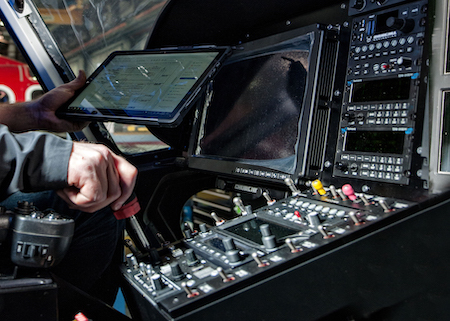|
Oct
17
2022
|
|
Posted 3 years 83 days ago ago by Admin
|
|

According to the historical website marconiheritage.org, the world’s first air-to-ground wireless communications occurred on 27th August 1910 when Canadian aviation pioneer John Alexander Douglas McCurdy transmitted a Morse code message to Henry M. Horton, as McCurdy flew over the Sheepshead Bay race track in Brooklyn.
The first voice communications between an aircraft and the ground took place in 1915, when the Royal Flying Corps’ Captain C.E. Prince radioed Captain J.M. Furnival as he circled overhead. 'Hello Furnie. If you can hear me now it will be the first time speech has ever been communicated to an aeroplane in flight,” said Captain Prince. He then added, “Hello Furnie, if you can hear me dip your wings” -- and Captain Furnival waggled his wings in response.
Progress in the other direction was swift. “In June 1915, the world’s first air-to-ground voice transmission took place at Brooklands, England, over about 20 miles,” says the BAA Training website (www.baatraining.com). “The first time airplanes in-flight communicated with each other directly via radio was on 2 September 1916.”
Practical two-way aerial radios soon followed and were deployed into World War I aircraft as a matter of course. When the revolutionary Sikorsky R-4 helicopter went into service in World War II, a radio was part of its core equipment.
Today, radio remains a vital element of helicopter communications. But just as helicopters themselves have advanced from the R-4, so have helicopter communication systems. Here’s a look at what is cutting-edge today, and what is on the horizon for tomorrow.

Expanding In-Flight Connectivity
The ground-based world relies on high speed data communications through the internet and other broadband networks to conduct its business. Now, the same is possible in the air thanks to companies such as Flightcell International, which builds/sells aircraft communication systems that operate on the Iridium satellite and 4G cellular networks.
“Voice communications and aircraft tracking have been available for a while now,” says James Mace, director of Flightcell International. “The more recent advances involve the provision of data connectivity to the helicopter over cellular or satellite, which in turn facilitate new capabilities on the helicopter. This includes streaming video and other data, and sending and receiving mission or medical data. These new services are valuable not so much for the pilots, but rather for the mission crew, whether the mission be law enforcement, search and rescue, or air ambulance.”

Plugging into P25 Ground Comms
The development of interoperable Project 25 (P25) land mobile radios (LMRs), which was spurred on by first responder communications problems during 9/11, has provided police, fire and EMS agencies with a common radio platform that allows everyone to hear and talk to each other.
These days P25 interoperability is finding its way onto helicopters. James Huddock, director of federal /military /OEM sales and programs with Technisonic Industries Limited reason says,
“Mission-based airborne communications in the helicopter world are mainly driven by the need of commercial and federal operators.In both cases P25 LMR technologies are the
core requirement as a federal radio requirement mandates the need to support P25 interoperability in the aircraft; that has become a baseline for just about all operators across the spectrum.”
The need to support P25 and other communications protocols into helicopters is motivating comms manufacturers to develop the airborne equipment to meet this demand. “For Technisonic, this resulted in the release of our Multi-Communication Port (MCP),” Huddock says. “The MCP allows for the onboard integration of simple devices such as handhelds or portables, to more advanced communication devices such as satellite or other non-aviation radios sets, directly into the existing comms platform.”
Meanwhile, in the interests of reducing the size, weight, and complexity of cable bundles, Technisonic recently introduced a digital interconnection system for its TDAP-650 audio panel. “This interconnect allows for a simple two-wire digital connection between the radio and the audio panel, eliminating the heavy, bulky wire bundles running through-out the aircraft to support comms,” says Huddock.

Wireless Comms Convenience
Until recently, the great irony of aircraft wireless communications is that the actual headsets or helmets used by helicopter pilots or other crew members were connected to their radios/intercoms by wired drop cords. These drop cords, although convenient, tethered helicopter crews to their aircraft, limiting their mobility and freedom of movement within and even in close proximity outside the aircraft cabin.
Today, pilots/copilots remain plugged into their helicopter’s wired comms system for safety reasons. But Axnes' PNG WICS has solved this problem for everyone else by allowing aft crew members such as EMS personnel, hoist operators and SARs technicians to connect wirelessly through the use of onboard base stations, control panels, and handheld wireless transceivers that connect to their headsets and helmets. “We eliminate the wires between the aircraft and headsets/helmets so that crew members can move around freely within the cabin,” says Markus Schmitz, managing director of Axnes’ U.S. operation. “Because our PNG system uses the UHF band, our handheld transceivers allow users to not only move within the cabin and around the aircraft, but also to achieve significant communication distances during airborne operations, typically up to 3-5 miles away, depending on the terrain and elevation.”
Adding wireless connectivity – in this case by using Bluetooth – is just one feature of Anodyne Electronics Manufacturing (AEM) Corporation’s P139-HD Digital Audio System, “which is the industry's most capable digital audio system for special role aircraft,” says Tony Weller, AEM’s director of sales and marketing. The P139-HD can go wireless by adding the Bluetooth Audio Accessory (BAA01) to the helicopter’s control panel. “Enabling the Remote Transmit selection feature of the P139-HD or adding the RTS01 to existing audio systems allows the user to conveniently toggle the TX Select to the desired communication radio without letting go of flight controls,” he says. AEM’s airborne comms equipment is being used by the Texas Department of Public Safety, U.S. Customs and Border Protection, Tokyo Metro Police, and Los Angeles County Sheriff’s Department, among others.

Better Quality Audio
Helicopters can be very noisy environments. Even with sound-proofed headsets, being able to understand what is being said by the ground and each other can be a real challenge for crew members.
Becker Avionics knows this, which is why the company has made intelligibility a top priority for its VHF radios and digital intercom systems. Lee Benson, a consultant with Becker Avionics, says these units provide true 3D audio, which allows for greater situational awareness of crew members. He explains this enhanced awareness, combined with the operational straightforwardness of Becker Avionics’ systems, results in a reduction in workload levels during critical flight phases.
AEM is similarly focussed on providing clear, understandable audio through its products. “Advances in audio clarity and custom configurability allow pilots to minimize distractions and focus their attention on critical communication,” Weller says. “By specifying isolated talk groups, communication can be routed to the individuals that need it, plus the nature of digital audio technology allows settings to be reconfigured by software if the operator needs to make a change or if new equipment is added.”

Advances Still Needed and Coming
Clearly, a lot of progress has been made in helicopter communications, and aviation communications in general. We’ve come a long way from ground crews communicating using waves, hand paddles, and signal flares. (Before airborne radio, pilots would put hand-written communications into ‘message bags’ attached to multi-colored streamers, and throw them to the ground.)
So what’s coming next? “As technology advances, we are going to see helicopter communication continue to become more intuitive and focused on increasing safety levels while decreasing the workload,” answers Weller. “With flexibility to build the communications around unique use cases, operators can focus more on their mission and less on switching or muting unnecessary audio interruptions.” Mace expects to see new comms technologies such as dedicated air-to-ground cellular networks, and higher bandwidth satellite networks. Meanwhile, Schmitz says Axnes is working on ways to boost the capabilities of existing technologies to provide enhanced voice, text, and video communications in flight, but that the details of their work is currently under wraps.
Incorporating radios into existing technologies (such as mapping systems, iPads and other standalone devices) is also on the horizon, predicts Huddock. “Such devices and their use continue to gain popularity and offer possibilities beyond a radio’s core capabilities by offering integrated data- and voice-driven communications,” he explains. “Such integration can seem like a major jump forward, though, and careful assessment is needed as the prospect of unintended consequences becomes a greater possibility. As such, support structures, software update compatibility, on-going maintenance, and the overall responsibility of such an integrated system needs to be well-defined prior to fielding.”
As for challenges that have yet to be resolved by helicopter communications systems? High on Benson’s list are “the integration of drones into helicopter airspace and 5G interference.” Weller adds that improvements in airborne systems’ weight, size and audio clarity can always be made. “Keeping pace with developments in other mission equipment will continue to be a challenge, as updates in technology are not always well coordinated with platforms that might be affected,” he says. “The key to success will be the ability to remain flexible in architecture and integration.”
James Mace says there’s still a need for “faster data speeds at lower cost,” while Huddock says that one of the biggest challenges faced today is one of “real estate,” both within the cockpit and the airframe overall. “As more and more mapping, data, and communication technology is installed in helicopters and as these technologies grow in scope and capability, the need to facilitate those signals grows, and unfortunately not always in a proportionate way,” he observes. “Limited antenna and pedestal space is already causing operators to pick and choose what is truly needed, as quite simply space won’t allow for another antenna without then possibly introducing crosstalk and interference issues with another system. Going forward, this seems to be becoming the biggest challenge for helicopter comms – not the technology, but the infrastructure and real estate needed to support it.”
What all of these challenges have in common is that none of them are insurmountable; figuring them out is just a matter of dedicated research and development, testing, innovative design, and human will. So it seems reasonable to assume the advances in helicopter communications will continue unabated, perhaps moving to a future of holograms and augmented reality/virtual reality interactions, all made possible by the same radio frequency spectrum that allowed Captain Prince to tell ‘Furnie’ to waggle his wings 107 years ago.
READ MORE ROTOR PRO: https://justhelicopters.com/Magazine
WATCH ROTOR PRO YOUTUBE CHANNEL: https://buff.ly/3Md0T3y
You can also find us on
Instagram - https://www.instagram.com/rotorpro1
Facebook - https://www.facebook.com/rotorpro1
Twitter - https://twitter.com/justhelicopters
LinkedIn - https://www.linkedin.com/company/rotorpro1